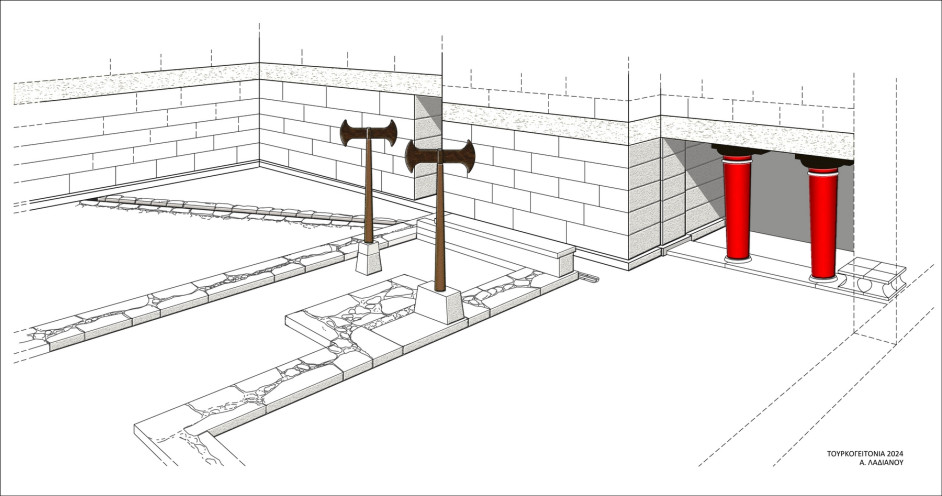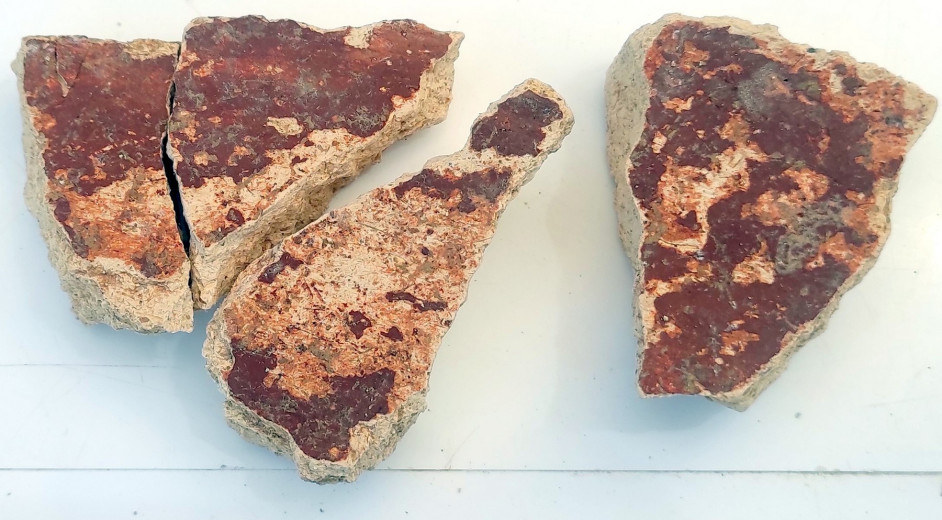It is a Sanctuary Gate, a unique element, found for the first time in a Minoan palace, outside its main entrance
An important and rare find was reserved by this year’s excavation at the Minoan palace of Archana in Crete, where the archaeologist Dr. Efi Sapuna-Sakellarakis continued the archaeological research to complete the image of the three-story building, which played, alongside Knossos, an important role in development of the Minoan culture. It is a Gate Sanctuary, a unique element, found for the first time in Minoan palaceoutside its main entrance, in the same spot where four altars have been uncovered, as well as the two arms of the stone platform structure, which together indicate the religious importance of the site.
Also in this year’s excavation, in addition to a double chisel base that was previously uncovered, another pyramidal base was found on the platform, while the existence of a third is also possible, as it is partially preserved in the western arm.
OR Efi Sapuna- Sakellaraki “returned”, for the second year, to the Minoan palace of Archana, after the great archaeological research that revealed it, in the 60s the hoe of the great archaeologist Yiannis Sakellarakis to be continued by her in the following decades. The goal was to clarify some building remains, but the excavations yielded impressive information.
In detail, in the southern part of this year’s research, a courtyard, south of the entrance with the four altars, a section of space 96 sq.m. was excavated. On the eastern side the excavation initially encountered a huge embankment of a number of fallen massive stones. Very few finds came from this layer (ceramics from the later periods, together with ceramics from the Greek periods, Mycenaean and a little Palaeolithic).
Beneath a disturbed layer, in the southernmost part of this year’s excavation, the Mycenaean destruction layer was revealed by a fire that had destroyed part of Minoan palace. (The Archanes and other Minoan palaces continued to be used in the Mycenaean era with repairs / recapture by the Mycenaeans). From here came a number of Mycenaean jars in a fragmentary state as the destruction that had occurred was great and the movable Minoan finds were few, with typical examples, a part of a stone relief vessel, part of a crystal vase, etc.
The revelation of the building system of a Holy Gate at the entrance of the palace with the altars and the arms of the stone structure, which framed a platform and two more altars – the large oblong and the stepped altar – which had been revealed in earlier excavation periods was the most interesting. .
Mycenaean gate sanctuaries have been dealt with by S. Charitonidis (1960) with the main example being a niche on the inner side of the Gate of Lions in Mycenae – a proposition that has been disputed, however, by other scholars – while later gate sanctuaries are mentioned in honor of gods, such as Artemis, parallel to other examples from classical times. In Crete, moreover, Eileithyia Prothyrea, a Cretan deity par excellence, is mentioned, declaring her protection in a place.
Also of interest is a stone base, uncovered under the massive stones to the south of the entrance with the four altars. The plinth had fallen from an upper floor together with remains of burnt wood and four distinctive bronze objects/hooks, a finding leading to the hypothesis that they were links to a wooden plinth resting on it. This is an element that shows that the upper floor of a room to the east of the courtyard had a sacred character.
In the northernmost part of the palace, two- and three-story spaces were revealed, of a special wing of the palace with luxurious rooms, which communicated with each other by corridors and doors, at the base of which shiny plasters, slate floors, etc. were revealed. In situ, the usual in almost all palace areas, separating/decorative bands of mortar, which surrounded the floor slabs, were found.
Fallen mortars were also found with parts of frescoes, some of which preserve blue and red paint. Finally, in the westernmost part, part of the facade of a door was revealed, which preserves the lintel and pilaster base, in its northern part, made of bright plaster.
The first to mention the Archanes was Sir Arthur Evans, due to important finds (now in the Asmolean museum) which apparently came from the Minoan cemetery of the Archanes on the Fourni hill, which was later excavated by Giannis and Efi Sakellarakis and which he attributed five vaulted tombs, several burial buildings and box-shaped tombs from the Mycenaean period.
In the town itself, Evans had observed surfaces of large walls and had excavated part of a circular aqueduct in an area near the palace in search of, according to the Victorian notions of his time, the “summer palace” of Knossos. A belief that was also embraced by other researchers (Marinatos, Plato).
The mapping, however, of all the aforementioned residues from the Yannis Sakellarakis led to the selection of a site, which proved to be the center of the palace, which yielded a wealth of architectural and luxury mobile finds. Moreover, in a neighboring area, the Archives and the theater area of the palace were found (Yiannis and Efi Sakellarakis, Archanes A New Look at Minoan Crete Vol. I & II, Athens, 1997).
The excavation at Archanes for the period of 2024 was carried out by the Athens Archaeological Society under the direction of Dr. Efi Sapunas-Sakellarakis with scientific staff Dr. Polina Sapunas-Ellis, Dimitris Kokkinakos (MA) and Persephone Xylouris.
Source :Skai
I am Frederick Tuttle, who works in 247 News Agency as an author and mostly cover entertainment news. I have worked in this industry for 10 years and have gained a lot of experience. I am a very hard worker and always strive to get the best out of my work. I am also very passionate about my work and always try to keep up with the latest news and trends.












